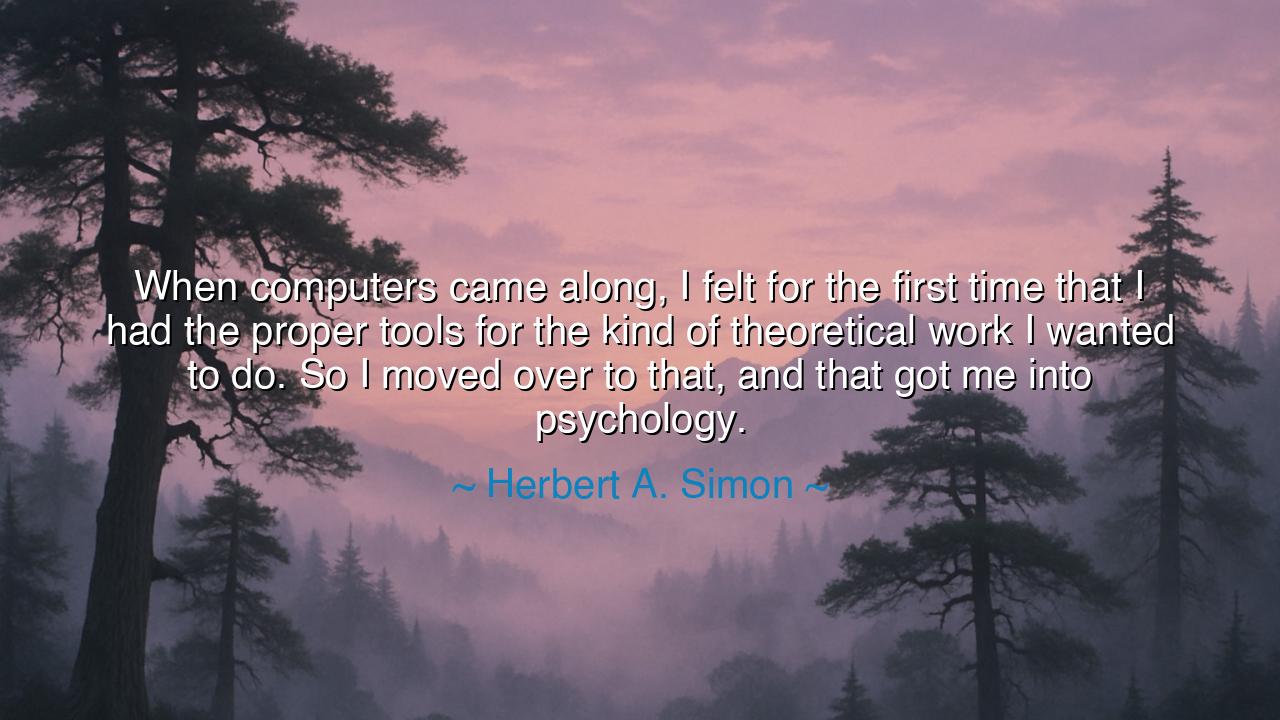
When computers came along, I felt for the first time that I had
When computers came along, I felt for the first time that I had the proper tools for the kind of theoretical work I wanted to do. So I moved over to that, and that got me into psychology.






When Herbert A. Simon said, “When computers came along, I felt for the first time that I had the proper tools for the kind of theoretical work I wanted to do. So I moved over to that, and that got me into psychology,” he spoke as one standing at the threshold between two ages—the age of pure thought and the age of simulated intelligence. His words carry the quiet awe of a scholar who, after years of seeking, at last finds an instrument worthy of his vision. In this confession lies the essence of human progress: the eternal dance between mind and tool, between imagination and the creations that make imagination tangible.
Simon was not merely a scientist; he was a philosopher of the human mind. His fascination was with how people think, decide, and solve problems. Before the advent of computers, such mysteries could only be approached through intuition or observation. But when those first glowing machines appeared—vast, humming, mysterious—Simon saw not just circuitry, but the mirror of human reasoning. In the machine’s logic, he saw the possibility of modeling thought itself. To him, the computer was not a cold instrument; it was the dawn of a new way to understand the soul’s architecture.
This transition—from mathematics and economics to psychology and artificial intelligence—was a bold one, the act of a mind that refused to be confined by boundaries. The ancients spoke of the philosopher as a seeker who walks between worlds: between heaven and earth, between idea and matter. So too did Simon walk between the abstract and the human, between machine precision and the messy glory of emotion. His discovery reminds us that true genius is not static—it evolves, following the pull of curiosity wherever it may lead.
Consider the story of Alan Turing, who, decades before Simon’s declaration, dared to ask whether machines could think. Turing built the foundations of computation not out of cold logic, but from a deep longing to understand the workings of the mind. Like Simon, he saw in the computer not an enemy of humanity but an ally—a partner in the exploration of consciousness itself. Both men lived in times when their ideas were radical, even heretical, yet they pursued them with the devotion of monks in the temple of thought. Their courage reminds us that every new tool demands new philosophy, and that the birth of a machine often births a new way of seeing ourselves.
Simon’s statement also reveals a profound humility before the power of tools. He did not claim mastery over the computer; instead, he acknowledged that it opened doors he could not enter alone. In this humility lies a deep truth: tools do not make us gods—they make us learners again. Each great innovation, from the printing press to the telescope to the digital processor, humbles its creator. It shows us not how much we know, but how much we have yet to understand. Simon’s embrace of the computer was not the abandonment of humanity, but a renewed devotion to it through the language of logic and code.
Through his journey, psychology itself evolved. By applying computational thinking to human thought, Simon helped forge the field of cognitive science, blending philosophy, technology, and empirical study. In the patterns of programs, he found reflections of reasoning; in the algorithms of decision-making, he glimpsed the mechanisms of choice. He taught us that understanding the machine is another path to understanding ourselves, for both follow the same sacred rhythm of input, transformation, and output—the eternal cycle of cause and consciousness.
Yet Simon’s lesson is not only for scholars. It is for every soul who has ever stood before a new creation and wondered, “What can this teach me about myself?” The computer was his gateway, but for another it might be art, or music, or medicine. Each tool humanity invents can become, in the right hands, a mirror reflecting our own potential. The secret lies in the courage to move over to it, to follow inspiration beyond comfort, as Simon did.
Final Lesson: Progress is born when curiosity meets courage. Tools alone do not change the world—it is the vision of the heart that wields them.
Practical Actions: When a new tool enters your life, learn it deeply. Let it transform not only your skill, but your understanding of yourself. Do not fear to step from one path to another if your spirit calls you there. For as Herbert A. Simon showed, every age of discovery belongs not to the machine, but to the soul brave enough to use it for wisdom.






AAdministratorAdministrator
Welcome, honored guests. Please leave a comment, we will respond soon